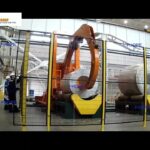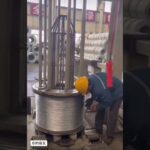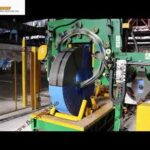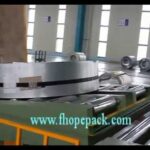Future Trends in Coil Packing: What to Expect Next
Is your coil packaging draining profits through damage claims and inefficient processes? As steel coils grow more valuable, traditional methods struggle to meet modern demands for perfect protection, sustainability, and ROI. Automation isn’t the future—it’s the present necessity.
Rising automation, AI-driven intelligence, material innovation, and tighter eco-regulations will dominate coil packing’s future. Fully integrated lines now achieve 60+ coils/hour with 40% waste reduction while eliminating manual handling risks. Emerging technologies like IoT sensors and biodegradable films transform protection from passive wrapping to active preservation systems that communicate data and prevent corrosion proactively.
The race toward smarter, greener coil packaging accelerates as producers face stiffer penalties for waste and carbon emissions. These seismic shifts demand strategic adaptation—here’s how industry leaders are responding.
Automation Surge: Beyond Human Limits
Manual coil packaging drowns in injuries, inconsistencies, and throughput caps of barely 1 coil/hour. Robotic arms now orchestrate entire lines: AMR forklifts transport 45-ton coils, vision-guided wrappers seal with airtight precision, and strappers tension-adjust using real-time load sensors.
Integrated automation slashes labor needs by 80% while boosting throughput to 60-90 coils/hour—producing ROI from 9–24 months via reclaimed productivity and material optimization. Systems like Pesmel’s TEW lines or Signode’s CoilMaster auto-apply wraps at 0.01mm tolerance, cutting film/strap waste by 30% while eliminating telescoping damage during extreme transit conditions.
Quantifying the Efficiency Revolution
Automation’s payback extends beyond speed. Sensor-driven precision converts into measurable gains across operations:
| Metric | Manual/Semi-Auto | Fully Automated Line | Improvement |
|---|---|---|---|
| Coils per Hour | 1–8 | 20–90 | Up to 11x faster |
| Labor Cost per Coil | $12–$18 | $1.50–$3 | 85% reduction |
| Damage Claims Rate | 8–15% | <1% | Save $500K+/year |
| Packaging Material Waste | 25% overuse | 3–5% variance | Save $200K/year |
| Changeover Time | 15–40 min | 3–7 min | 84% faster |
JSW Steel’s automated yard exemplifies systemic gains: after deploying Pesmel’s ASRS and TEW tech, throughput jumped >50 coils/hour. Damage became statistically insignificant, requiring just one supervisor for a 14-coil storage grid—squeezing 4x space efficiency while slashing forklift accidents.
Core drivers–PLCs, MES/ERP integration, and IIoT networks–unlock predictive maintenance. Amova’s smart lines spot bearing failures 72 hours pre-breakdown, cutting downtime costs by $18K/hour. Future evolution leans on autonomous coordination: KUKA bots now learn stacking patterns via deep learning, while FANUC’s AI-pathfinding AGVs reroute around bottlenecks.
Sustainable Materials: Beyond Plastic Straps
Virgin plastic wraps and chemical rust inhibitors face extinction. Stricter EPR laws now fine producers for non-recycled content, while maritime customers like Maersk demand carbon-neutral packaging.
Nitrite-free VCI films, mushroom-based edge protectors, and PCR plastics now dominate innovation. BioArmor’s seaweed wrap decomposes in 8 weeks, Pesmel’s Through-Eye-Wrapping cuts film usage 40%, while steel strapping’s 99% recyclability dominates EU markets. Kraft-laminate shields replace wooden skids—stopping mold growth without toxic treatments.
Trade-offs in Eco-Materials Evolution
Sustainable alternatives balance performance with planetary impact:
| Material | Protection Level | Recyclability | Carbon Reduction | Commercial Viability |
|---|---|---|---|---|
| Steel Strapping | ★★★★★ | 96% recycled | Low | Global supply chains |
| Bio-PET Film | ★★☆☆☆ | Industrially compostable | 78% vs PE | Limited scalability |
| VCI Kraft Paper | ★★★★☆ | Pulp-recyclable | 65% | Cost+30% over plastic |
| Edible Algae Coating | ★☆☆☆☆ | Biodegrades in weeks | 91% | Pilot phase only |
| LLDPE 70% PCR | ★★★☆☆ | Recyclable (facility-dependent) | 44% | Immediate adoption |
Cortec’s BioPads® merge VCI chemistry with food-safe cellulose, replacing toxic oils while resisting salt-spray corrosion for 24 months. Yet tech gaps linger: many biodegradable films tear below 10,000N tension. Until bio-polymers match PE’s puncture resistance, hybrid solutions rule—GEORG’s Re:Wrap blends 30% ocean plastic with virgin PET to satisfy UK Plastic Tax without risking transit fails.
Industry 4.0: The Data-Driven Coil
Coils no longer ship silent. IoT temperature/humidity loggers now embedded in labels ping shippers when condensation risks rust. AI vision scanners inspect wraps for 0.2mm gaps at 12 coils/minute, while blockchain ledgers auto-verify recyclable content percentages for EU auditors.
Smart packaging generates 30+ data points per coil—predicting shelf life via corrosion algorithms and optimizing routes via real-time load stability metrics. Lines using OPC UA protocols boost OEE by 22% through predictive maintenance, slashing $200K in annual repair costs.
Smart Line Integration Framework
Next-gen systems fuse hardware and analytics across four layers:
1. Sensor Layer (Real-Time Monitoring)
- Strain gauges – Track wrapping tension (±2% accuracy)
- LiDAR – Maps coil position for robotic pickers
- Spectral cameras – Detect micro-rust under wraps
- Vibration sensors – Warn of imbalance during transit
2. Control Layer (Automated Adjustment)
- PLCs – Automate strap tension based on coil weight class
- Dynamic wrapper heads – Adjust overlap % when humidity rises
- AMRs – Reroute coils if storage zone reaches capacity
3. Intelligence Layer (AI Analytics)
| AI Application | Data Source | Business Impact |
|---------------------|----------------------|--------------------------------------|
| Predictive Defects | Vibration + Temp history | 89% early corrosion detection |
| Palletizing Optimo | Coil diameter/weight | 17% warehouse space savings |
| Carbon Footprint Calc | Material/Wattage logs | Automatic EPR compliance reports |4. Enterprise Layer (Strategic Oversight)
Oracle Cloud SCM users like Alcar Ruote cut inventory errors by 200% using packaging-line data synced to ERP. Digital twins—like Nippon Steel’s logistics simulator—pressure-test hurricane scenarios before storms hit.
Regulatory Shifts and Cost Impacts
Non-compliance penalties now cripple laggards. EU’s Carbon Border Tax adds €55/ton for packaging with >55% virgin plastic, while California’s SB54 demands 100% recyclability by 2032.
EPR schemes shift recycling costs onto producers—eco-modulated fees spike 200% for unrecyclable composites. Producers gain via material-light designs: TEW wrapping qualifies for "wide-loop recycling" discounts, while reusable CakeBoxx containers slash per-shipment fees by 78%.
Investments now pivot to alignment. Signode’s RADIAL™ straps satisfy Australia’s ISPM-15 while cutting wood use by half. Blockchain material passports help exporters prove PCR content percentile amid German LUCID audits. Through 2030, spending will focus on dual-certified solutions: anti-corrosion and zero-waste. JSW Steel’s $2M automation retrofit achieved 18-month ROI solely via waste-reduction fines avoidance—proving compliance is profit.
Automation, eco-materials, and granular data control define the coil packaging horizon. Leaders embracing integrated lines, like Pesmel’s TEW systems, slash costs by 40% while future-proofing against regulatory shocks. Industry 4.0 intelligence redefines the Future of Packing from passive protection to asset optimization—where steel ships flawless, recyclable, and instantly traceable.











